11 Metrics Every Marketing Manager Needs to Track
How successful are your marketing campaigns?
Believe it or not, this seemingly simple question puzzles many marketers and business owners I work with.
You’re running ads, and customers are buying what you’re selling, so your marketing efforts must be working, right? Not necessarily.
Don’t get me wrong. I’m not saying this means your strategies have failed. In fact, some of your campaigns may be working great. But you can’t make any assumptions.
The only way to know for sure whether your campaigns are working is to measure the results.
By tracking certain metrics, you’ll also be able to save some money. You don’t want to dump money into campaigns that aren’t working.
Here’s the problem. Sometimes it’s difficult to directly tie one promotion to a sale.
That’s why you need to track several metrics and infer based on the results.
This statement holds true for all marketers, regardless of your industry or the size of your business. It doesn’t matter if you’re running expensive campaigns or using tactics to market your company on a budget. You need to track the results.
As I’m sure you know, there are dozens of business metrics you could be tracking. But not all of these will benefit your marketing strategy.
That was my inspiration for this guide. I narrowed down the top 11 metrics every marketing manager needs to track to be successful.
Use this guide as a reference to measure the success of your marketing campaigns moving forward. Based on the results, you’ll be able to tell what’s working and which strategies need improvement.
1. Average order value
The average order value, or AOV, is one of the first things you need to prioritize as a marketing manager.
This metric will help you figure out how to get your existing customers to spend more money each time they shop. It’s arguably the most important number to track when trying to understand consumer spending habits.
The average order value formula is quite simple:
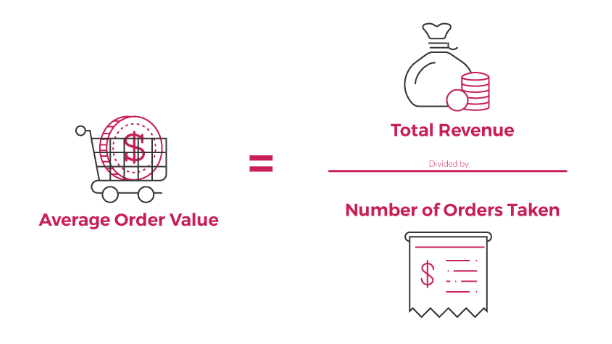
Just divide your total revenue by the total number of transactions.
You don’t need to look at it every day or after each campaign. AOV is a metric that you need to keep an eye on over time.
If it rises at certain times, you could potentially connect it to campaigns run during that time.
But if it falls, you’re obviously doing something you want to avoid. These issues need to be addressed.
In my consulting work, I see many businesses using only their number of transactions to gauge success. Is it great to make 100 sales in a day? It depends.
I’d rather make 50 sales for $2,500 than 100 sales for $1,000. Or even better, 100 sales for $6,000.
Do you see the difference? That’s where average order value comes into play.
You want to try to get as much money as possible from your existing customers. To do this, you’ll want to encourage them to add more items to their carts or buy other products of higher values.
Both of these will increase your AOV.
2. Customer lifetime value
The concept behind customer lifetime value is simple.
This metric will tell you the amount of money a customer will spend before leaving your business. Here is the formula to calculate it:

Customers who stay with your business for a long time become more profitable.
As a marketer, you need to make sure the lifetime value of your customers is as high as possible.
The best way to do this is by focusing on customer retention as opposed to customer acquisition, which I’ll talk about in greater detail shortly.
Yes, you want new customers. But it’s easier to market to people already familiar with your brand, products, and services.
Research shows that your existing customers will spend 67% more than new customers. This will also increase your average order value, which I just talked about.
Keep in mind customer lifetime value when thinking about your acquisition strategies as well. All too often I see businesses make the mistake of shying away from certain strategies because they don’t seem profitable.
But that’s only because they’re using the AOV to make this decision. If the AOV is less than the acquisition cost, they won’t use that acquisition strategy.
However, they’re not accounting for how much that customer will spend over time. That’s why this metric is so important to track.
Plus, you can also learn how to use lifetime value to create a Facebook audience that actually converts.
3. Sales conversions
This connects to a point I made earlier.
How can you tell if the number of sales you have each day, week, or month is sufficient?
To a certain extent, the number of transactions isn’t that important. What’s much more telling when measuring the success of your marketing efforts is your sales conversion rates.
To calculate this, divide the number of sales by the number of visitors to your website.
Here’s a look at the average sales conversion rates for ecommerce shops.
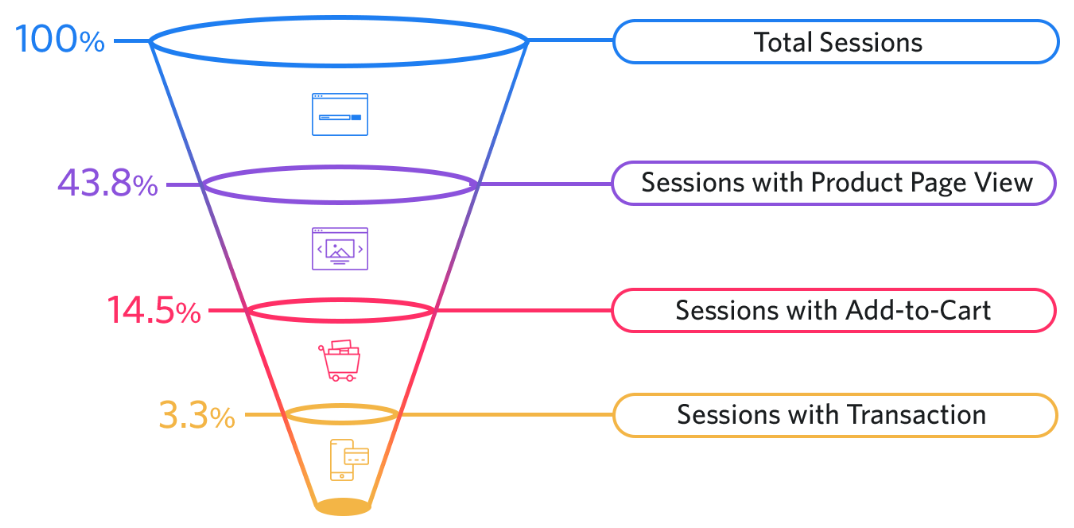
Based on this information, 3.3% is adequate. But who wants to be average?
By regularly tracking your sales conversion rate, you’ll be able to determine how much of your traffic is actually converting.
Having low conversions does not mean your marketing efforts are at fault. If people are navigating to your site at a high rate, something else could be preventing them from converting.
That’s when you need to analyze your web design. Websites with simple designs have higher conversion rates.
You’ll never get a 100% sales conversion rate. But you should always try to increase this number.
These people are already on your website. Sometimes they are just a click or two away from buying. It’s your job to make sure that happens.
4. Cart abandonment rates
Calculating cart abandonment rate is simple.
Divide the number of transactions by the number of carts created. You want this metric to be as low as possible.
As I just pointed out, when someone adds something to a shopping cart, they are only a step or two away from converting. You need to identify what stopped them from finalizing the purchase.
These are the top reasons for shopping cart abandonment during the checkout process:
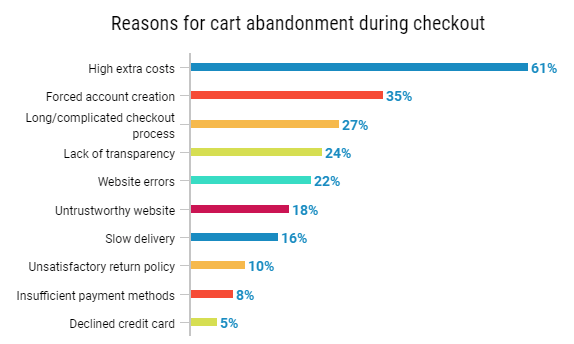
Similar to sales conversions, your cart abandonment rate may not be a marketing issue.
There could be a problem with your site. But you don’t want to let your marketing efforts go to waste.
Change your promotions if you have to.
As you can see, high extra costs ranked first on the list of reasons for cart abandonment. Don’t charge your customers for shipping, and highlight that in your marketing campaigns.
You’re doing a great job of getting people to visit your site and add items to their carts. Now you just need them to convert.
5. Revenue by reference source
So, you’ve got lots of website traffic. But where is it coming from?
By tracking the revenue by referral source, you’ll be able to determine which channels are the most profitable for your business.
This is important for both B2C and B2B companies. Here’s a look at the top channels for leads and revenue on the B2B side:
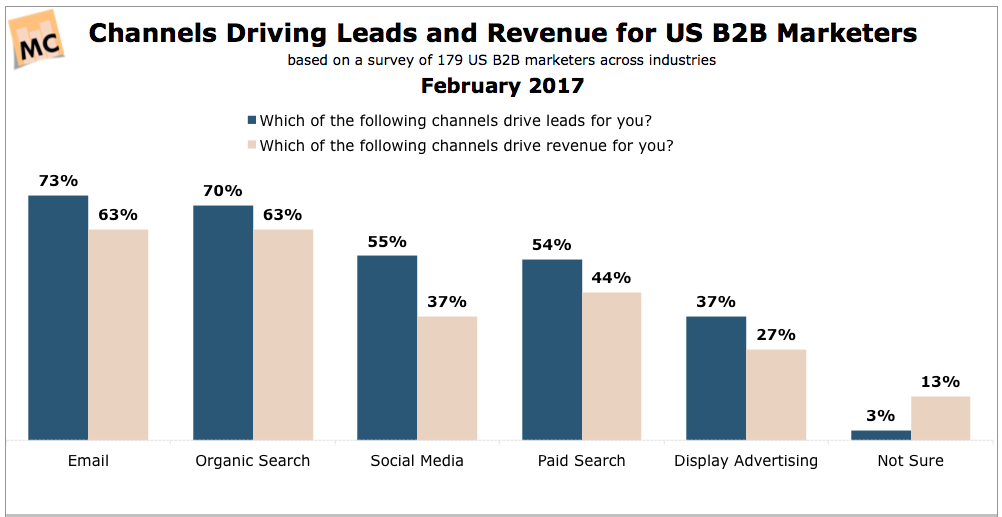
You might be getting tons of traffic from one source, but if you’re not making money from those leads, you need to reevaluate your strategy.
On the flip side, maybe traffic from a certain source is not high, but the revenue from that channel is the highest.
You need to figure out how to get more traffic from your marketing channels yielding the highest revenue. At the same time, you must learn how to increase conversions and the AOV from your distribution channels resulting in the most traffic to your site.
6. Social media engagement
I’m sure social media is a huge part of your company’s marketing strategy, as it should be.
You’re posting content on all your social channels each day. That’s great. But how effective are those posts?
Again, the only way to find out is to measure the results.
These are the top metrics used to measure success on social media:
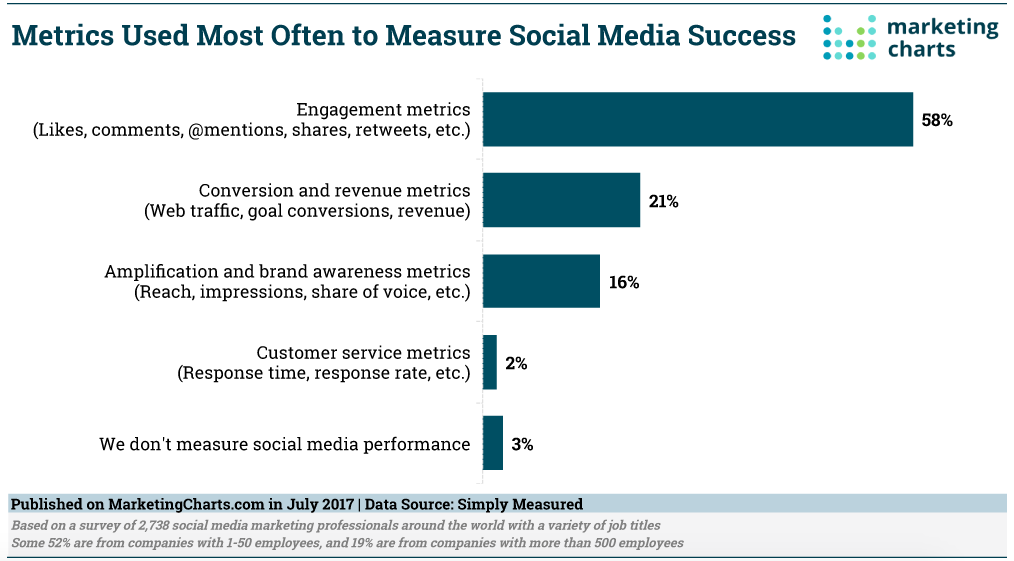
The information you get from tracking these metrics will be extremely beneficial to your marketing strategy.
You need to analyze the difference between your top performing content and the posts with lower engagement. Figure out why certain posts do better than others.
For example, you may find out your videos get more comments and shares than your photos.
Obviously, you’d want to run more video campaigns on social media once you know that.
7. Email open rates
Your email open rates should be easy to track. I doubt you’ll have to do any manual calculations for this metric.
Whichever software you’re using for email marketing should automatically do this for you.
That said, don’t just look at these numbers. Analyze them.
Are your open rates fluctuating? Do they stay consistent?
Find out what you need to do for your open rates to improve.
These are the top reasons why people open emails:
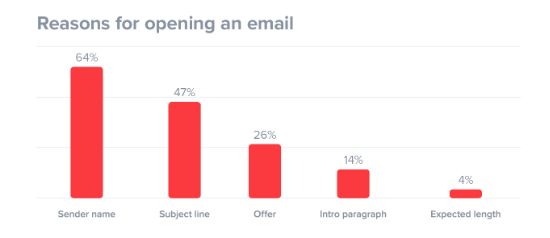
If your open rates are low, I recommend reading my guide on how to increase open rates with your subject lines.
You spend much time building your email list and segmenting your subscribers accordingly.
Then, you send various email campaigns to each group of subscribers. Don’t let those efforts go to waste.
Your message is useless if nobody reads it. That’s why you need to track your open rates for every campaign and compare those percentages over time.
8. CTA click-through rates
Customers can’t spend money unless they click on your CTA.
It’s necessary to track the click-through rates of all these buttons.
It doesn’t matter what landing page the button leads to or what channel it’s on, you have to track it. Your ads, emails, website, and social media campaigns will all have CTAs.
Compare these rates to each other. Which buttons have the highest CTR?
Based on these metrics, you can hypothesize which wording or types of offers people are more likely to click on.
Then, you can run A/B campaigns to check your theory: test CTAs’ wording, color, size, placement, etc. This strategy will give you the most optimal results for your CTA buttons.
9. Customer acquisition cost
Earlier, I briefly talked about customer acquisition when discussing customer lifetime value.
You need to know your acquisition cost, or you might run the risk of going broke. Here’s the simple formula for you to follow:

If your acquisition costs are too high, you’ll need to change your marketing strategy or potentially even raise your prices.
But a price increase could have its potential pitfalls as well.
Customer acquisition cost is crucial for all businesses, but it’s especially important for startup companies.
Those of you with a newer company know what it’s like to have to manage a tight budget. Simply put, if your acquisition costs get too high, you’ll run out of money before you have enough customers to give you a sustainable income.
That’s why investors always want to know your acquisition costs before they’ll consider giving you a dime.
Lower acquisition costs will result in a higher ROI for your marketing efforts and make it easier for your brand to grow exponentially over time.
10. Keywords that drive traffic
Marketing managers need to prioritize SEO.
You can’t just rely on traffic coming from your distribution channels and people navigating directly to your website. Your company needs to be visible and have a high ranking through organic search results as well.
That’s why you need to track metrics for keywords related to your brand. Then you’ll be able to use SEO tactics to drive ecommerce sales.
Find out which keywords are performing the best and which keywords are the most competitive. Once you start using these words and phrases, you’ll need to track the success of them as well.
This information will be useful for your on-page optimization efforts as well as your PPC campaigns.
You don’t want to pay for keywords that aren’t driving traffic and sales.
11. ROI of influencer campaigns
Influencer marketing is growing in popularity. If you haven’t tried this strategy yet, I highly recommend it.
But you need to approach this tactic like every other marketing campaign. If it’s not profitable, you need to abandon it.
Don’t just blindly throw money at influencers without knowing whether those efforts are working. Track the ROI of each campaign.
Take a look at how much businesses are spending on their influencer marketing programs:
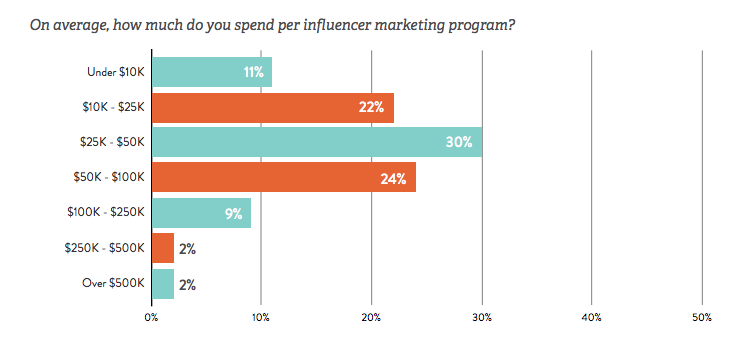
Furthermore, 39% of marketers said they planned to increase their influencer marketing budget in 2018.
And 90% of these marketers say they use engagement metrics to determine the success of their influencer campaigns. I talked about the importance of tracking engagement earlier.
Basically, you need to find out whether the money spent on influencers is generating a return on your investment.
One of the best ways to do this is by giving each influencer a unique promo code. It will make it easier for you to track which influencers are driving the most sales.
You need to cut ties with influencers who aren’t profitable and continue working with the ones driving traffic and revenue to your site. But the only way to determine this is by tracking the ROI of each campaign.
Conclusion
Nobody said being a marketing manager would be easy. Anyone could just throw together a campaign and run it.
Successful businesses track metrics to ensure their marketing campaigns are profitable.
If you’re not doing this, you’re throwing away money.
If you haven’t been tracking metrics related to your marketing campaigns, it’s certainly not too late to start.
Don’t get overwhelmed. Start going through the list I’ve outlined above.
Some of these metrics will be specific to individual campaigns, while others should be tracked over time to help you identify patterns.
I’m confident your marketing efforts will improve and you’ll see higher profits once you start tracking these 11 metrics.
What metrics are you using to track the success of your marketing campaigns?
COntributer : Quick Sprout https://ift.tt/2JRoAzB
 Reviewed by mimisabreena
on
Saturday, November 10, 2018
Rating:
Reviewed by mimisabreena
on
Saturday, November 10, 2018
Rating:

















No comments:
Post a Comment